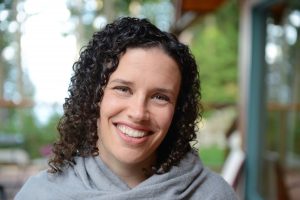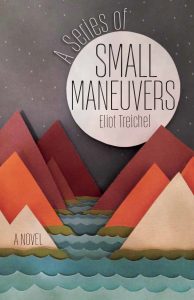 Abbey Gaterud directs Portland State University’s Ooligan Press, which is part of its unique master’s in book publishing program. She is a PSU alum and a book designer and was recognized by Publisher’s Weekly in 2015 as a Star Watch honoree.
Abbey Gaterud directs Portland State University’s Ooligan Press, which is part of its unique master’s in book publishing program. She is a PSU alum and a book designer and was recognized by Publisher’s Weekly in 2015 as a Star Watch honoree.
Ed Battistella: How did Ooligan press get started?
Abbey Gaterud: The book publishing program at PSU was launched in the Fall of 2001 and as part of the curriculum, Ooligan Press was born.
EB: Ooligan is a teaching press. How does that process work?
AG: Ooligan Press is part of the master’s in book publishing program. As such, it’s the place where students put into practice the theory and skills they are learning in their other classes (like editing, design, marketing, digital). We consider Ooligan to be the central component to the experiential education that the master’s degree provides.
EB: At the press, what do the students have responsibility for and what do the faculty have responsibility for?
AG: The students are responsible for everything. As the only faculty member dedicated to Ooligan, I serve as the publisher and that really means I make sure that we are on the right track with schedules, funds, the boring logistical stuff. The students get to be in charge of all the fun stuff: they work directly with our authors to edit the books; they are in charge of the design of the book, from cover to cover; they design and implement the marketing and sales strategies that we use to get the books into the hands of readers; and they tackle the always-changing digital publishing world of ebooks, websites, and whatever else is happening now. Students run the show.
EB: What does Ooligan look for in a book and in an author?
AG: We publish books with a Pacific Northwest connection. That can come from the author, the subject matter, the story itself. We look for authors who want to work with an ambitious group of young professionals and authors who respect the process of practice as learning. We look for authors who are not afraid to work with a large team, because that’s what we are at Ooligan: a big team of really excited young professionals.
EB: Ooligan seems to have a wide-variety of titles. Is there any particular publishing niche that the press is aiming for?
 AG: Our backlist is certainly more eclectic than our current publishing mission. We have focused much more in the last five years on staying true to our regional roots. We have the most success with books that live in the Pacific Northwest and with books that tell stories not usually taken on by larger publishers. As part of the master’s curriculum, we have a bit more leeway in choosing books for their subject merits rather than their profitability. Our books support themselves (we don’t have any standing funding for the production of our books from PSU), but they don’t have to support the operations of a publishing house in terms of salaries, rents, or any of those real costs for more traditional publishers. That said, the books do have to support themselves, so their viability in the marketplace is certainly a factor when we acquire a title.
AG: Our backlist is certainly more eclectic than our current publishing mission. We have focused much more in the last five years on staying true to our regional roots. We have the most success with books that live in the Pacific Northwest and with books that tell stories not usually taken on by larger publishers. As part of the master’s curriculum, we have a bit more leeway in choosing books for their subject merits rather than their profitability. Our books support themselves (we don’t have any standing funding for the production of our books from PSU), but they don’t have to support the operations of a publishing house in terms of salaries, rents, or any of those real costs for more traditional publishers. That said, the books do have to support themselves, so their viability in the marketplace is certainly a factor when we acquire a title.
EB: Where can readers get your books?
AG: Anywhere you buy books. We encourage supporting your local bookstore and library, but our books are available worldwide via all the major retailers.
EB: Tell us a little about your own background and what you hope to accomplish at Ooligan?
AG: I have a background in design and production, but I’ve been at PSU for ten years now and it feels like my focus is all about collaboration, creative problem solving, and constantly asking what we can do better. My main goal at Ooligan is to be a constant, fixed foundation from which our students and graduates can launch themselves into the publishing world—in whatever way that suits them best. I want our students to excel in the literary world and I want them to be able to not just adapt to the changing publishing and reading ecosystem, but to lead that change. I want our graduates to have the confidence and skill to question the changes that are coming and to put them in context, so that we make good decisions as an industry when facing the challenges of a new media landscape.
What that means for Ooligan is that we take each project as a new platform for experimentation. Whether that’s a technical change in the way we edit, code, or design the books, or something bigger like a total revamping of the means of production, we question the process each time we take on a new project. This makes publishing a book not just a series of the same old steps, over and over again, but a chance to make up the steps as we go. We’re not afraid to try something new and that makes this the most exciting place for publishing professionals to get their start.
EB: What excites you the most about the publishing trade and working with students?
AG: Right now we’re in the middle of a huge change in the way we read and the way we publish. It’s amazing to be in a place where there’s no clinging to the past and the way this have always been done. Students are always up for hard work and are constantly excited about their projects—these are the first books they’ve published and the enthusiasm and passion for the projects carries an amazing amount of energy along with it. So for me, I get to be carried along with that energy, rather than feeling like I’ve been working in the same place for ten years. It’s something new and exciting every term, every year, and that keeps everyone busy and engaged.
EB: Thanks for talking with us!
AG: Thanks for having me. Our websites have a huge amount of information and I’d encourage people who want to know more about the publishing process to check our Write to Publish, our annual conference dedicated to demystifying publishing for writers. More info here: https://ooligan.pdx.edu/events/writetopublish/

 Follow
Follow